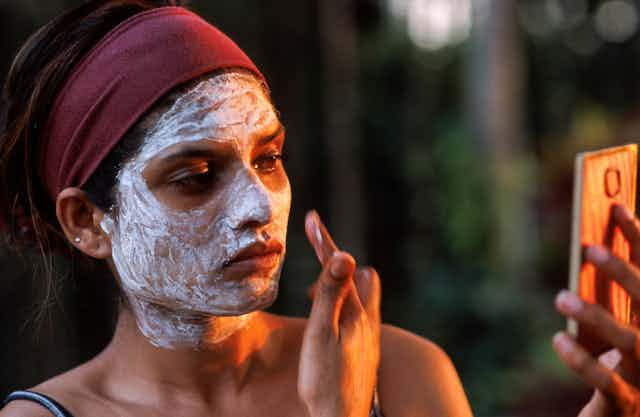In a recent BBC documentary, entitled Beauty and the Bleach, presenter Tan France (of Queer Eye fame) tackles the issue of colourism. Also known as pigmentocracy, colourism is defined as discrimination that privileges light-skinned people of colour over their darker-skinned peers.
France was born in Doncaster, South Yorkshire, to Pakistani immigrant parents. He says he had always assumed that colourism had “something to do with colonialism”. He also illustrates, with harrowing personal stories, how it comes from within one’s own community. “It’s our own people who are saying that we are not worthy,” he says. “We are not worthy unless we are light-skinned.”
As a system, colourism is deeply rooted in the violence of colonial history. The slave-owning colonial societies of the Caribbean and the United States sustained myths of white racial purity. Preferential treatment of lighter-skinned slaves and the “one drop rule” led to lighter skin shades being associated with status and respectability.
My research shows that colourism was also commodified during the late colonial period, by an imperially supported capitalist economy that racialised Indians. France rightly notes that the south Asian or brown experience cannot be conflated with the Black experience, not least because of the prevalence of anti-blackness within many South Asian communities.
However, both Black and south Asian people continue to grapple with the legacies of their colonial histories. They continue to experience racism too.

Rooted in colonial narratives
Historically, Indians and Europeans alike popularised perceptions of south Indians and lower castes as darker skinned. In the late 18th and 19th centuries orientalists held that Aryan peoples had displaced indigenous Dravidians across the Indian subcontinent, from around 2000 to 1600 BC.
Colonial thinkers distinguished between “strong pale Aryans” and small dark-skinned primitive Dravidians. Colonial ethnographer HH Risley further racialised Indians by codifying different castes ranging from “Dead Black” to “Flushed Ivory”.
These ideas fed into European civilisational ideas of superiority and progress, which were selectively adopted by other groups. Certain north Indian and Bengali muslims, for instance, connected Persian and Afghan heritage to Aryan genealogies.
So although caste and connections to skin colour were not created by European thinkers, they were consolidated by the British colonial state. Groups from the northern regions of India, deemed lighter-skinned and stronger, were classified as martial races and recruited into the colonial army. Later, through the 1881 and 1901 censuses, racialised caste descriptions became a matter of public record. Across Indian society, fair skin continued to hold currency.
How skin lightening became a big industry
Long before Unilever launched its Fair and Lovely cream in 1971, European and US companies commodified skin lightening in colonial India. Early 20th-century marketing for soaps and creams, as well as skin-lighteners, promoted ideals of superior hygiene, femininity and whiteness to Indian consumers. Local Indian entrepreneurs capitalised on their popularity, connecting fairer skin to class mobility.

The idea that “lighter means beautiful” was also reinforced, from the turn of the 20th century, by commercial photography and cinema in both Hollywood and Bollywood. And when people from south Asia and the Caribbean migrated to the UK, these preferences for lighter skin were transported to post-war Britain.
This discrimination compounded the racism they experienced at the hands of white British communities. France recounts his childhood trauma of facing racism outside and colourism at home. In the 1970s and 1980s, in Black and south Asian communities in Britain, skin shade remained associated with the very real question of social mobility.
Voices of resistance
In colonial India, there was some pushback against colourism. Anti-caste thinkers including Jyotirao Phule and BR Ambedkar rejected ideas that endorsed Aryan and Brahman superiority. Opposition to colour-based prejudice could also be found in popular poetry as well as in debates in women’s periodicals.
In the US and in Britain, from the 1960s, Black power movements and anti-racist socialist organising embraced the Black is beautiful discourse. This idea resurfaced more recently, in 2017, in a campaign launched by the Indian non-governmental organisation, Women of Worth, entitled Dark is Beautiful.
In post-apartheid South Africa activists inspired by anti-colonial thinking have attempted to ban skin lighteners and their harmful ingredients. However, the use of these products remains complex.
Some people view skin-lighteners as a modern beauty choice. Along with new lightening technologies, including laser treatments and plastic surgery, these products remain hugely popular. Social media filters, meanwhile, continue to value lighter skin tones.
In 2020, Unilever announced it was replacing “fair” in its Fair & Lovely product range with “glow”. My research highlights how the choice of “glow” is reminiscent of early 20th-century advertising – products are simply rebranded to align them with a more contemporary stance.
Much of France’s documentary focuses on his sense of shame at having on two occasions – at 9 and 16 – bleached his skin. But it was a response to racism and seen as a “matter of survival”. Skin-lightening, for many, is still seen as a means of accessing the social capital needed to improve prospects, from better career opportunities to romantic relationships.

France dwells on the role community elders play in perpetuating this idea. Many south Asian women continue to share older advice about foods to eat or concoctions to make to improve skin colour and glow.
If these practices, like the discrimination at their root, have long been what singer Kelly Rowland describes in the documentary as the “said unsaid” within communities of colour, the historic resistance to them is finding new voices.
Across mainstream and social media, British Black and south Asian people are speaking out. As a second-generation British Pakistani woman, this is what I try to do too. France’s documentary stands as a poignant challenge to speak openly about these painful truths.

